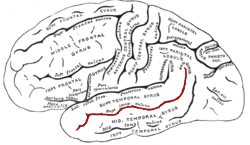
Agnosia is the inability to process sensory information. Often there is a loss of ability to recognize objects, persons, sounds, shapes, or smells while the specific sense is not defective nor is there any significant memory loss. It is usually associated with brain injury or neurological illness, particularly after damage to the occipitotemporal border, which is part of the ventral stream. Agnosia only affects a single modality, such as vision or hearing. More recently, a top-down interruption is considered to cause the disturbance of handling perceptual information.

Facial perception is an individual's understanding and interpretation of the face. Here, perception implies the presence of consciousness and hence excludes automated facial recognition systems. Although facial recognition is found in other species, this article focuses on facial perception in humans.

Prosopagnosia, also known as face blindness, is a cognitive disorder of face perception in which the ability to recognize familiar faces, including one's own face (self-recognition), is impaired, while other aspects of visual processing and intellectual functioning remain intact. The term originally referred to a condition following acute brain damage, but a congenital or developmental form of the disorder also exists, with a prevalence of 2.5%. The brain area usually associated with prosopagnosia is the fusiform gyrus, which activates specifically in response to faces. The functionality of the fusiform gyrus allows most people to recognize faces in more detail than they do similarly complex inanimate objects. For those with prosopagnosia, the method for recognizing faces depends on the less sensitive object-recognition system. The right hemisphere fusiform gyrus is more often involved in familiar face recognition than the left. It remains unclear whether the fusiform gyrus is specific for the recognition of human faces or if it is also involved in highly trained visual stimuli.

The Thatcher effect or Thatcher illusion is a phenomenon where it becomes more difficult to detect local feature changes in an upside-down face, despite identical changes being obvious in an upright face. It is named after the then British prime minister Margaret Thatcher, on whose photograph the effect was first demonstrated. The effect was originally created in 1980 by Peter Thompson, Professor of Psychology at the University of York.

Associative visual agnosia is a form of visual agnosia. It is an impairment in recognition or assigning meaning to a stimulus that is accurately perceived and not associated with a generalized deficit in intelligence, memory, language or attention. The disorder appears to be very uncommon in a "pure" or uncomplicated form and is usually accompanied by other complex neuropsychological problems due to the nature of the etiology. Affected individuals can accurately distinguish the object, as demonstrated by the ability to draw a picture of it or categorize accurately, yet they are unable to identify the object, its features or its functions.
Visual agnosia is an impairment in recognition of visually presented objects. It is not due to a deficit in vision, language, memory, or intellect. While cortical blindness results from lesions to primary visual cortex, visual agnosia is often due to damage to more anterior cortex such as the posterior occipital and/or temporal lobe(s) in the brain.[2] There are two types of visual agnosia: apperceptive agnosia and associative agnosia.

The inferior temporal gyrus is one of three gyri of the temporal lobe and is located below the middle temporal gyrus, connected behind with the inferior occipital gyrus; it also extends around the infero-lateral border on to the inferior surface of the temporal lobe, where it is limited by the inferior sulcus. This region is one of the higher levels of the ventral stream of visual processing, associated with the representation of objects, places, faces, and colors. It may also be involved in face perception, and in the recognition of numbers and words.
Visual search is a type of perceptual task requiring attention that typically involves an active scan of the visual environment for a particular object or feature among other objects or features. Visual search can take place with or without eye movements. The ability to consciously locate an object or target amongst a complex array of stimuli has been extensively studied over the past 40 years. Practical examples of using visual search can be seen in everyday life, such as when one is picking out a product on a supermarket shelf, when animals are searching for food among piles of leaves, when trying to find a friend in a large crowd of people, or simply when playing visual search games such as Where's Wally?

The fusiform face area is a part of the human visual system that is specialized for facial recognition. It is located in the inferior temporal cortex (IT), in the fusiform gyrus.

The Mooney Face Test, developed by Craig M. Mooney, was first introduced in his 1957 article “Age in the development of closure ability in children.” Participants in the test are shown series of black and white distorted photographs, presented in such a way that would require them to perform closure. The law of closure is one of the seven Gestalt principles that describes a tendency of our perception to view an incomplete object as continuing and complete. The test assumes that perception is based on the collected information taken from the different regions of the image, which then constitute a holistic representation of a face. Today, there are many iterations of the Mooney Face Test, a number of which contain images that involve image color inversion and facial feature scrambling.
The greebles are artificial objects designed to be used as stimuli in psychological studies of object and face recognition. They were named by the American psychologist Robert Abelson. The greebles were created for Isabel Gauthier's dissertation work at Yale, so as to share constraints with faces: they have a small number of parts in a common configuration. Greebles have appeared in psychology textbooks, and in more than 25 scientific articles on perception. They are often used in mental rotation task experiments.
The cross-race effect is the tendency to more easily recognize faces that belong to one's own racial group. In social psychology, the cross-race effect is described as the "ingroup advantage," whereas in other fields, the effect can be seen as a specific form of the "ingroup advantage" since it is only applied in interracial or inter-ethnic situations. The cross-race effect is thought to contribute to difficulties in cross-race identification, as well as implicit racial bias.
Prosopamnesia is a selective neurological impairment in the ability to learn new faces. There is a special neural circuit for the processing of faces as opposed to other non-face objects. Prosopamnesia is a deficit in the part of this circuit responsible for encoding perceptions as memories.

The superior temporal sulcus (STS) is the sulcus separating the superior temporal gyrus from the middle temporal gyrus in the temporal lobe of the brain. A sulcus is a deep groove that curves into the largest part of the brain, the cerebrum, and a gyrus is a ridge that curves outward of the cerebrum.
Visual object recognition refers to the ability to identify the objects in view based on visual input. One important signature of visual object recognition is "object invariance", or the ability to identify objects across changes in the detailed context in which objects are viewed, including changes in illumination, object pose, and background context.
The N170 is a component of the event-related potential (ERP) that reflects the neural processing of faces, familiar objects or words. Furthermore, the N170 is modulated by prediction error processes.
Images and other stimuli contain both local features and global features. Precedence refers to the level of processing to which attention is first directed. Global precedence occurs when an individual more readily identifies the global feature when presented with a stimulus containing both global and local features. The global aspect of an object embodies the larger, overall image as a whole, whereas the local aspect consists of the individual features that make up this larger whole. Global processing is the act of processing a visual stimulus holistically. Although global precedence is generally more prevalent than local precedence, local precedence also occurs under certain circumstances and for certain individuals. Global precedence is closely related to the Gestalt principles of grouping in that the global whole is a grouping of proximal and similar objects. Within global precedence, there is also the global interference effect, which occurs when an individual is directed to identify the local characteristic, and the global characteristic subsequently interferes by slowing the reaction time.
In psychology, the face superiority effect refers to the phenomena of how all individuals perceive and encode other human faces in memory. Rather than perceiving and encoding single features of a face, we perceive and encode a human face as one holistic unified element. This phenomenon aids our visual system in the recognition of thousands of faces, a task that would be difficult if it were necessary to recognize sets of individual features and characteristics. However, this effect is limited to perceiving upright faces and does not occur when a face is at an unusual angle, such as when faces are upside-down or contorted in phenomena like the Thatcher effect and Pareidolia.
Prosopometamorphopsia is a visual disorder characterized by altered perceptions of faces. Facial features are distorted in a variety of ways including drooping, swelling, discoloration, and shifts of position. Prosopometamorphopsia is distinct from prosopagnosia which is characterised by the inability to recognise faces. About 75 cases of prosopometamorphopsia have been reported in the scientific literature. In about half of the reported cases, features on both sides of the face appear distorted. In the other half of cases, distortions are restricted to one side of the face and this condition is called hemi-prosopometamorphopsia.
The occipital face area (OFA) is a region of the human cerebral cortex which is specialised for face perception. The OFA is located on the lateral surface of the occipital lobe adjacent to the inferior occipital gyrus. The OFA comprises a network of brain regions including the fusiform face area (FFA) and posterior superior temporal sulcus (STS) which support facial processing.









